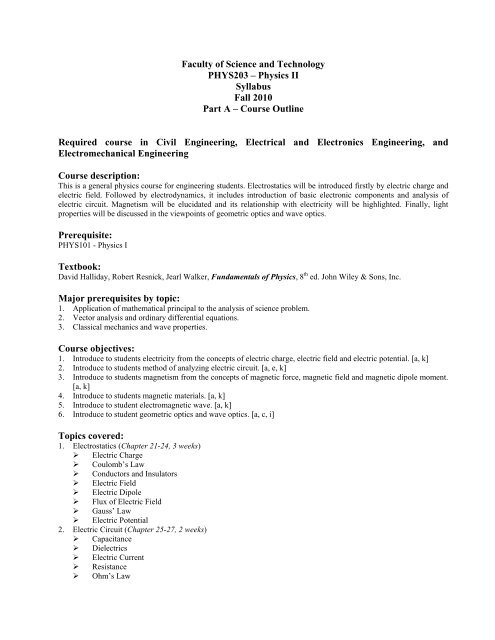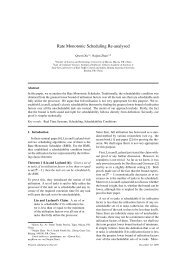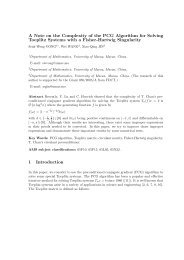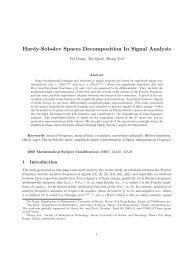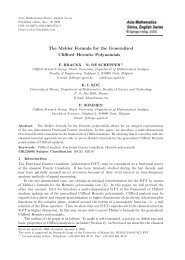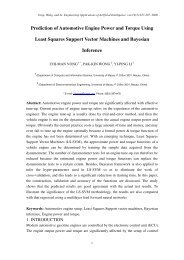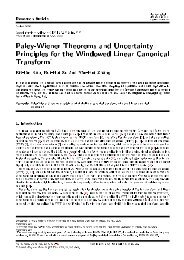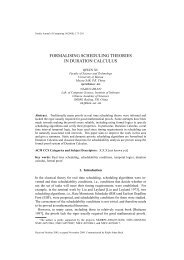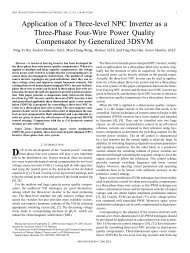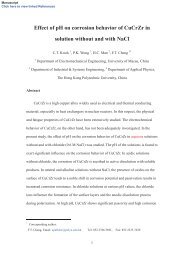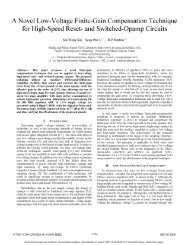Faculty of Science and Technology PHYS203 â Physics II Syllabus ...
Faculty of Science and Technology PHYS203 â Physics II Syllabus ...
Faculty of Science and Technology PHYS203 â Physics II Syllabus ...
Create successful ePaper yourself
Turn your PDF publications into a flip-book with our unique Google optimized e-Paper software.
<strong>Faculty</strong> <strong>of</strong> <strong>Science</strong> <strong>and</strong> <strong>Technology</strong><br />
<strong>PHYS203</strong> – <strong>Physics</strong> <strong>II</strong><br />
<strong>Syllabus</strong><br />
Fall 2010<br />
Part A – Course Outline<br />
Required course in Civil Engineering, Electrical <strong>and</strong> Electronics Engineering, <strong>and</strong><br />
Electromechanical Engineering<br />
Course description:<br />
This is a general physics course for engineering students. Electrostatics will be introduced firstly by electric charge <strong>and</strong><br />
electric field. Followed by electrodynamics, it includes introduction <strong>of</strong> basic electronic components <strong>and</strong> analysis <strong>of</strong><br />
electric circuit. Magnetism will be elucidated <strong>and</strong> its relationship with electricity will be highlighted. Finally, light<br />
properties will be discussed in the viewpoints <strong>of</strong> geometric optics <strong>and</strong> wave optics.<br />
Prerequisite:<br />
PHYS101 - <strong>Physics</strong> I<br />
Textbook:<br />
David Halliday, Robert Resnick, Jearl Walker, Fundamentals <strong>of</strong> <strong>Physics</strong>, 8 th ed. John Wiley & Sons, Inc.<br />
Major prerequisites by topic:<br />
1. Application <strong>of</strong> mathematical principal to the analysis <strong>of</strong> science problem.<br />
2. Vector analysis <strong>and</strong> ordinary differential equations.<br />
3. Classical mechanics <strong>and</strong> wave properties.<br />
Course objectives:<br />
1. Introduce to students electricity from the concepts <strong>of</strong> electric charge, electric field <strong>and</strong> electric potential. [a, k]<br />
2. Introduce to students method <strong>of</strong> analyzing electric circuit. [a, e, k]<br />
3. Introduce to students magnetism from the concepts <strong>of</strong> magnetic force, magnetic field <strong>and</strong> magnetic dipole moment.<br />
[a, k]<br />
4. Introduce to students magnetic materials. [a, k]<br />
5. Introduce to student electromagnetic wave. [a, k]<br />
6. Introduce to student geometric optics <strong>and</strong> wave optics. [a, c, i]<br />
Topics covered:<br />
1. Electrostatics (Chapter 21-24, 3 weeks)<br />
‣ Electric Charge<br />
‣ Coulomb’s Law<br />
‣ Conductors <strong>and</strong> Insulators<br />
‣ Electric Field<br />
‣ Electric Dipole<br />
‣ Flux <strong>of</strong> Electric Field<br />
‣ Gauss’ Law<br />
‣ Electric Potential<br />
2. Electric Circuit (Chapter 25-27, 2 weeks)<br />
‣ Capacitance<br />
‣ Dielectrics<br />
‣ Electric Current<br />
‣ Resistance<br />
‣ Ohm’s Law
‣ Power in Electric Circuit<br />
‣ Work, Energy, <strong>and</strong> Emf<br />
‣ Single-Loop Circuit<br />
‣ Multiloop Circuit<br />
‣ RC Circuit<br />
3. Magnetism (Chapter 28-29, 1.5 weeks)<br />
‣ Magnetic Force<br />
‣ Magnetic Field<br />
‣ Cathode Ray Tube<br />
‣ Hall Effect<br />
‣ Torque on a current loop<br />
‣ Magnetic Dipole Moment<br />
‣ Ampere’s Law<br />
‣ Solenoids <strong>and</strong> Toroids<br />
4. Inductance (Chapter 30, 1.5 weeks)<br />
‣ Faraday’s Law<br />
‣ Lenz’s Law<br />
‣ Induction<br />
‣ Inductance<br />
‣ Self-Induction<br />
‣ RL Circuits<br />
‣ Energy Stored in Magnetic Field<br />
‣ Mutual Induction<br />
5. Alternating Fields (Chapter 31, 1 week)<br />
‣ LC Oscillations<br />
‣ Damped Oscillations in RLC Circuit<br />
‣ Alternating Current<br />
‣ Forced Oscillations<br />
‣ Power in Alternating-Current Circuits<br />
‣ Transformers<br />
6. Models <strong>of</strong> magnetism <strong>and</strong> Maxwell’s equations (Chapter 32, 1 week)<br />
‣ Gauss’ Law for Magnetic Field<br />
‣ Induced Magnetic Field<br />
‣ Displacement Current<br />
‣ Maxwell’s Equations<br />
‣ Magnetic Materials<br />
‣ Diamagnetism<br />
‣ Paramagnetism<br />
‣ Ferromagetism<br />
7. Electromagnetic Waves (Chapter 33, 1 week)<br />
‣ Traveling Electromagnetic Wave<br />
‣ Energy Transport<br />
‣ Radiation Pressure<br />
‣ Polarization<br />
‣ Reflection<br />
‣ Refraction<br />
‣ Total Internal Reflection<br />
‣ Polarization by Reflection<br />
8. Optics (Chapter 34-36, 2 weeks)<br />
‣ Two types <strong>of</strong> Image<br />
‣ Plane Mirrors<br />
‣ Spherical Mirrors<br />
‣ Thin Lenses<br />
‣ Optical instruments<br />
‣ Diffraction<br />
‣ Young’s Interference
‣ Coherence<br />
‣ Double-Slit Interference<br />
‣ Interference from Thin Films<br />
‣ Michelson Interferometer<br />
‣ Single-Slit Diffraction<br />
‣ Circular Aperture Diffraction<br />
‣ Double-Slit Diffraction<br />
‣ Diffraction Gratings<br />
‣ Dispersion <strong>and</strong> Resolving Power<br />
Class schedule <strong>and</strong> credits:<br />
Timetabled work in hours per week<br />
Lecture Tutorial Practice<br />
No <strong>of</strong><br />
teaching<br />
weeks<br />
Total hours Total credits No / Duration <strong>of</strong><br />
exam papers<br />
4 2 2 14 112 5.5 1 / 3hrs<br />
Contribution <strong>of</strong> course to meet the pr<strong>of</strong>essional component:<br />
This course prepares students to work pr<strong>of</strong>essionally in engineering area.<br />
Relationship to program outcomes:<br />
This course primarily contributes to program outcomes that develop student abilities to:<br />
(a) an ability to apply knowledge <strong>of</strong> mathematics, science <strong>and</strong> engineering.<br />
(e) an ability to identify, formulate, <strong>and</strong> solve engineering problems.<br />
(k) an ability to use techniques, skills, <strong>and</strong> modern engineering tools necessary for engineering practice.<br />
The course secondarily contributes to program outcomes that develop student abilities to:<br />
(c) an ability to design electrical circuit <strong>and</strong> optical system.<br />
(i) an ability to recognize the need for, <strong>and</strong> to engage in lifelong learning.<br />
Course content:<br />
Maths<br />
Engineering<br />
<strong>Science</strong><br />
Engineering<br />
Design <strong>and</strong><br />
Synthesis<br />
Complementary<br />
Studies<br />
Computer<br />
Studies<br />
Total 100%<br />
100 0 0 0 0 100<br />
Course modulator:<br />
Dr. Iat Neng Chan<br />
Persons who prepared this description:<br />
Dr. Sut Kam Ho, Dr. Iat Neng Chan, Pr<strong>of</strong>. Pak Kin Wong<br />
_________________________________________________________________________
Part B – General Course Information<br />
1 st Semester 2010/2011<br />
Instructor: Dr. Sut Kam Ho Office: N312<br />
Office Hour: by appointment Phone: (853) 83974362<br />
Email: phoebeho@umac.mo<br />
Assessment:<br />
Final assessment will be determined on the basis <strong>of</strong><br />
Quiz 25%<br />
Mid-term exam 35%<br />
Final exam 40%<br />
Laboratory performance will be contributed to the assessment <strong>of</strong> 50% <strong>of</strong> PHYS204 (<strong>Physics</strong> Laboratory) in Spring<br />
2010.<br />
Grading System:<br />
The credit is earned by the achievement <strong>of</strong> a grade from ‘A’ to ‘D’; ‘F’ carries zero credit.<br />
Grades are awarded according to the following system:<br />
Letter Grades Grade Points Percentage<br />
A 4.0 (Excellent) 93-100<br />
A- 3.7 (Very good) 88-92<br />
B+ 3.3 83-87<br />
B 3.0 (Good) 78-82<br />
B- 2.7 73-77<br />
C+ 2.3 68-72<br />
C 2.0 (Average) 63-67<br />
C- 1.7 58-62<br />
D+ 1.3 53-57<br />
D 1.0 (Pass) 50-52<br />
F 0 (Fail) Below 50<br />
Comment:<br />
The objective <strong>of</strong> the lectures is to explain the text material. Students are encouraged to look at the text prior to the<br />
lecture. Students who wish to succeed in this course should practice the suggested homework <strong>of</strong> each chapter.<br />
Quizzes:<br />
One mid-term exam will be held during the semester. There will be quiz in practice class every week.<br />
Note:<br />
1. Attendance <strong>of</strong> students will be recorded in every lecture class.<br />
2. Course materials will be uploaded in webcourse <strong>and</strong> it can be accessed by https://ummoodle.umac.mo/login.<br />
3. Report any mistake on grades within one week after announcement.
Appendix - Rubric for Program Outcomes<br />
Rubric for (a) 5 (Excellent) 3 (Average) 1 (Poor)<br />
Underst<strong>and</strong><br />
the theoretic<br />
background<br />
Use a correct<br />
model <strong>and</strong><br />
formulation<br />
correctly<br />
Students underst<strong>and</strong> theoretic<br />
background <strong>and</strong> the limitations<br />
<strong>of</strong> the respective applications.<br />
Students choose a model<br />
correctly <strong>and</strong> properly apply<br />
correct techniques<br />
Students have some confusion<br />
on some background or do not<br />
underst<strong>and</strong> theoretic<br />
background completely<br />
Students choose a wrong<br />
model sometime, use a wrong<br />
formula, or a different<br />
technique<br />
Students do not underst<strong>and</strong> the<br />
background or do not study at<br />
all<br />
Students use a wrong model<br />
<strong>and</strong> wrong formula, or do not<br />
know how to model<br />
Compute the<br />
problem<br />
correctly<br />
Students use correct techniques,<br />
analyze the problems, <strong>and</strong><br />
compute them correctly<br />
Students sometime solve<br />
problem mistakenly using<br />
wrong techniques<br />
Students do not know how to<br />
solve problems or use wrong<br />
techniques completely<br />
Rubric for (c) 5 (Excellent) 3 (Average) 1 (Poor)<br />
Design<br />
capability<br />
<strong>and</strong> design<br />
constraints<br />
Student underst<strong>and</strong>s very clearly<br />
what needs to be designed <strong>and</strong><br />
the realistic design constraints<br />
such as economic,<br />
environmental, social, political,<br />
ethical, health <strong>and</strong> safety,<br />
manufacturability, <strong>and</strong><br />
sustainability.<br />
Student underst<strong>and</strong>s what<br />
needs to be designed <strong>and</strong> the<br />
design constraints, but may not<br />
fully underst<strong>and</strong> the<br />
limitations <strong>of</strong> the design<br />
constraints<br />
Process to<br />
meet desired<br />
needs<br />
Student underst<strong>and</strong>s very clearly<br />
the process <strong>of</strong> the design<br />
Student underst<strong>and</strong>s what the<br />
needs <strong>of</strong> the process design,<br />
but may not fully underst<strong>and</strong><br />
the limitations <strong>of</strong> the design<br />
constraints<br />
Student does not underst<strong>and</strong><br />
what needs to be designed <strong>and</strong><br />
the design constraints.<br />
Student does not underst<strong>and</strong><br />
the process.<br />
Rubric for (e) 5 (Excellent) 3 (Average) 1 (Poor)<br />
Identify<br />
applications<br />
in<br />
engineering<br />
systems<br />
Students underst<strong>and</strong> problem<br />
<strong>and</strong> can identify fundamental<br />
formulation<br />
Students underst<strong>and</strong> problem<br />
but cannot apply formulation,<br />
or cannot underst<strong>and</strong> problem<br />
Modeling,<br />
problem<br />
formulation<br />
<strong>and</strong> problem<br />
solving<br />
Students choose <strong>and</strong> properly<br />
apply the correct techniques<br />
Students model correctly but<br />
cannot select proper technique<br />
or model incorrectly but solve<br />
correctly accordingly<br />
Students cannot identify<br />
correct terms for engineering<br />
applications<br />
Students at loss as to how to<br />
solve a problem
Rubric for (i) 5 (Excellent) 3 (Average) 1 (Poor)<br />
Research/<br />
Gathering<br />
Information<br />
Comprehensive collection <strong>of</strong><br />
information on a subject,<br />
including state-<strong>of</strong>-the-art <strong>and</strong><br />
Collects adequate information<br />
on a subject<br />
Collects minimal information<br />
on a subject<br />
Analysis/<br />
Evaluation<br />
background<br />
Detailed analysis accounting for<br />
all the information, conclusions<br />
are well supported<br />
Some analysis done but<br />
somewhat shallow; some<br />
supporting evidence<br />
Analysis simply involves<br />
restating gathered information;<br />
claims not supported by<br />
evidence<br />
Rubric for (k) 5 (Excellent) 3 (Average) 1 (Poor)<br />
Use suitable<br />
technique in<br />
engineering<br />
practice<br />
Student uses the technique to<br />
correctly analyze engineering<br />
problems, <strong>and</strong> underst<strong>and</strong>s the<br />
limitations <strong>of</strong> the technique.<br />
Student uses the technique to<br />
correctly analyze engineering<br />
problems.<br />
Student does not use the<br />
technique correctly <strong>and</strong>/or<br />
does not correctly interpret the<br />
results.


